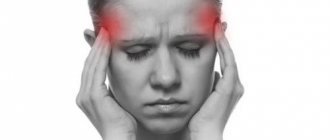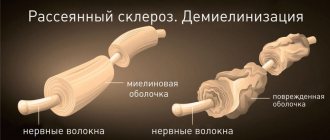According to the speed of development, they are distinguished:
- acute polyneuropathies develop in less than four weeks: the most common is Guillain-Barré syndrome;
- subacute polyneuropathy is called if the disease develops over 4-8 weeks;
- chronic course, when the disease develops for more than two months (8 weeks). The chronic course is more typical with alcoholism, uncompensated diabetes mellitus, vegetarianism, or simply poor nutrition leading to a deficiency of B vitamins, hereditary causes, inflammatory processes involving autoimmune mechanisms that primarily affect the myelin sheath of the nerves, etc.
In addition to the above, the cause of this disease can be: the use of neurotoxic drugs, chemotherapy, intoxication with salts of heavy metals, some chronic somatic diseases with symptoms of liver and kidney failure, diseases of the endocrine organs, for example, the thyroid gland.
Polyneuropathy also occurs in autoimmune diseases, both affecting predominantly peripheral nerves (Guillain-Barré syndrome, multifocal motor neuropathy, chronic inflammatory demyelinating polyneuropathy, paraproteinemic polyneuropathy) and systemic connective tissue diseases (rheumatoid arthritis, Sjögren's disease, systemic lupus erythematosus).
In the development of polyneuropathy, infectious factors of both a bacterial nature (borreliosis, botulism, diphtheria, syphilis, HIV infection) and viral (influenza, cytomegalovirus, herpes, etc.) often play an etiological role. A special place in the group of polyneuropathies is occupied by hereditary neurodegenerative diseases, such as transthyretin familial amyloid polyneuropathy, polyneuropathy with porphyria, hereditary neuropathy with a tendency to paralysis from compression.
Toxic polyneuropathies (information for patients and doctors)
Toxic polyneuropathy (information for patients and doctors) Alcoholic polyneuropathy
What is Alcoholic Polyneuropathy? “Alcoholic polyneuropathy” is a consequence of the direct toxic effect of ethanol and its metabolites on peripheral nerves with predominant damage to thin, weakly myelinated and unmyelinated fibers that conduct pain, temperature sensitivity and provide autonomic-trophic functions.
How common is this disease among the Russian population? In Russia, according to official data, about 5% of the population over the age of 18 abuses alcohol, which is about 7.5 million people. According to the WHO report, in 2021 our country was in fourth place in terms of the amount of alcohol consumed per capita (13.9 liters of pure alcohol per year), behind Lithuania, Belarus and Moldova. At the same time, in Russia they often drink strong alcoholic drinks, while in other European countries preference is given to beer and wine. In relation to polyneuropathies of other origins, the proportion of alcoholic damage to peripheral nerves is about 40%. According to the literature, 76% of patients suffering from alcohol dependence for more than 5 years have clear clinical signs of alcoholic polyneuropathy; At the same time, subclinical (“erased”, “hidden”) nerve damage according to electroneuromyography (ENMG) is detected in 97–100% of patients who chronically drink alcohol, that is, in the vast majority.
How do I know if I drink a lot of alcohol? The GAGE questionnaire will help answer this question. Answer the questions unequivocally “YES” or “NO” in the way you understand them. If you have difficulty answering, do not answer anything:
- Have you ever felt that you should cut down on your drinking?
- Did you feel irritated if someone around you (friends, relatives) told you about the need to reduce your drinking?
- Have you ever felt guilty about drinking alcohol?
- did you have the desire to drink alcohol as soon as you woke up after drinking alcoholic beverages?
Interpretation of results: for each answer “YES” - 1 point. A score of 2 or more points corresponds to SIGNIFICANT ALCOHOL ABUSE. You need to reconsider your lifestyle and eliminate the harmful effects of the toxic effects of alcohol on the body, in particular polyneuropathy. Yes, I scored more than 2 points, but what symptoms bother patients with alcoholic polyneuropathy? The first signs of the disease may not be immediately noticed by patients, since this type of polyneuropathy is characterized by a slow progression of symptoms over several years. Less commonly, the clinic can develop acutely, during or after a binge.
Depending on which nerve fibers are more involved in the pathological process, the following characteristic complaints arise:
- sensitive symptoms: numbness, tingling, “burning”, “burning”, pain, “crawling” in the feet, legs, and later in the hands; decreased sensitivity in the feet - “I don’t feel like I’m putting on shoes, I don’t feel the floor”; unsteadiness when walking, worse in the dark and with eyes closed;
- motor symptoms: weakness develops in the muscles of the feet and legs, then weakness in the muscles of the hands may develop (impaired fine motor skills); difficulty walking, “spanking” of the feet;
- autonomic symptoms: fluctuations in blood pressure; “interruptions” in the work of the heart; constipation, diarrhea; dry skin or sweating; erectile dysfunction and decreased libido;
- symptoms of concomitant damage to the central nervous system: memory impairment; confusion; decreased intelligence; disorientation; indifference to loved ones and others; inattention; drowsiness.
The clinical picture and “set” of symptoms may vary. In 42% of those diagnosed with alcoholic polyneuropathy, neuropathic pain syndrome is detected.
Are there risk factors for developing this disease? There definitely is! The most important factor is the frequency of alcohol consumption. There are 3 cohorts of patients who abuse alcohol: occasional drinkers (a period of sobriety of more than 5 days, without binge drinking), frequent drinkers (drinking alcohol more than 3 times a week with a hangover more than 1 time a week) and constant drinkers (daily drinking, without sobriety) . It was found that patients from the groups of “frequent drinkers” and “constant drinkers” have higher rates of detection of polyneuropathy (29.6% and 29.9%, respectively) than the group of patients “occasional drinkers” (11.3%). Subjective polyneuritic symptoms developed after a relatively short duration of abuse (1-5 years), and signs of severe polyneuropathy developed after alcohol abuse for more than 10 years. Female gender increases the risk of developing more severe polyneuropathy. Such gender differences are due to a higher rate of absorption of alcohol and, as a consequence, a higher level of alcohol in the blood in women than in men. Women's addiction and full-fledged dependence on alcohol develop much faster than in men. If in men chronic alcoholism (first-second stage) develops after 6-12 months of daily drinking, then for women 3-6 months are enough. The genetic risk factor manifests itself, first of all, in a hereditary craving for alcohol, which can, from generation to generation, lead to the development of alcoholic polyneuropathy and damage to other organs and systems. Malnutrition and B vitamin deficiency often accompany alcohol abuse. It has been proven that ethanol reduces the absorption of vitamins in the small intestine, reduces their “liver” reserves, and disrupts the processes of phosphorylation and the formation of active forms of vitamins. Deficiency of B vitamins is an additional cause of peripheral nerve damage, which, together with the toxic effects of alcohol, aggravates the course of polyneuropathy. Impaired liver function is caused by a long period of alcohol intake or the addition of other concomitant diseases. As a result, fatty hepatosis occurs, which over time can transform into alcoholic hepatitis and cirrhosis of the liver. Liver failure is a separate cause of damage to peripheral nerves, and when caused by alcohol, it leads to severe polyneuropathy.
What type of alcohol increases the risk of developing polyneuropathy? Any type of alcohol contains ethanol and its metabolites, mainly acetaldehyde, which has a direct toxic effect on peripheral nerves. Scientists from the Maugeri Medical Detoxification Center conducted a comparative analysis of alcoholic beverages consumed by their patients. It was found that drinking wine, compared to drinking beer, causes a greater risk of developing polyneuropathy. This may be due to the presence of impurities that wine producers add to their product. No other comparative studies have been conducted on this topic.
What is the mechanism of nerve damage caused by alcohol consumption? Alcohol enters the bloodstream within 5 minutes of ingestion and reaches its peak after 30–90 minutes. Ethanol and its toxic metabolites affect the functioning of neurons. Free oxygen radicals disrupt the function of cellular structures, primarily the vascular endothelium, causing endoneurial hypoxia and leading to damage to nerve axons. In addition, ethanol reduces the synthesis and disrupts the normal configuration of nerve fiber cytoskeletal proteins and slows down axonal transport.
On what basis did the doctor diagnose “Alcoholic polyneuropathy”? The key to making a diagnosis is a history of systematic or binge drinking of alcohol, the absence of anamnestic and clinical and laboratory signs of other probable causes of polyneuropathy: diabetic, hereditary, dysimmune, etc. To confirm the diagnosis and exclude alternative causes of polyneuropathy, the doctor may order the following tests:
- electroneuromyography, which allows you to assess the functional state of motor and sensory fibers of peripheral nerves and determine the nature of their damage;
- general blood analysis;
- detailed biochemical blood test;
- glycated hemoglobin and glucose tolerance test;
- blood test for HIV, RW, hepatitis B and C;
- blood test for levels of vitamins B1, B6, B9, B12, homocysteine;
- rheumatic tests (rheumatic factor, antineuronal antibodies ANCA, antinuclear factor, antibodies to nuclear antigens ANA, antibodies to cyclic citrullinated peptide, antinuclear antibodies, etc.);
- antineuronal antibodies (anti-Hu, anti-CV2/CRMP-5).
- electrophoresis of serum and urine proteins with immunofixation + freelite.
To diagnose polyneuropathy with predominant damage to thin, weakly myelinated nerve fibers, additional research methods are used:
- cardiovascular tests, assessment of heart rate variability, tilt test;
- autonomic evoked potentials;
- corneal confocal microscopy;
- quantitative sensory testing;
- punch skin biopsy with assessment of the condition of intraepidermal thin nerve fibers.
What treatment can a neurologist prescribe? The main and main stage of treatment is a complete cessation of drinking alcohol. Observation by a narcologist will be useful. Pathogenetic therapy for alcoholic polyneuropathy has not yet been developed. A nutritious, balanced diet with sufficient amounts of vitamins and protein and other lifestyle changes (quitting smoking, normalizing body weight) themselves contribute to a significant improvement in the condition of patients with alcohol-related illness. In cases of concomitant deficiency of B vitamins, vitamins B1 (thiamine), B6 (pyridoxine), B9 (folic acid), B12 (cyanocobalamin) are prescribed. In the presence of neuropathic pain syndrome, medications are prescribed according to the symptoms of its correction: antidepressants (amitriptyline, duloxetine, venlafaxine) and anticonvulsants (gabapentin, pregabalin). Restorative and rehabilitation methods of treatment (transcutaneous electrical neurostimulation, myostimulation, acupuncture, biofeedback, massage, physiotherapy, balance therapy, robotic therapy) occupy an important place in the correction of polyneuritic disorders. If you have symptoms of polyneuropathy and you scored 2 or more points on the GAGE questionnaire, then you urgently need to seek specialized medical care at the Center for Diseases of the Peripheral Nervous System of the Federal State Budgetary Institution National Center for Neuroscience!
Drug-induced and chemotherapy-induced polyneuropathy What do these terms mean? Drug-induced polyneuropathy is multiple, diffuse, uniform and symmetrical damage to peripheral nerves that develops while taking a drug with a high and moderate degree of neurotoxicity. Chemotherapy-induced polyneuropathy that develops during or after chemotherapy is considered separately.
How common is this disease? The prevalence of all drug-induced polyneuropathies has not been reliably determined. At the same time, the prevalence of polyneuropathy among cancer patients receiving chemotherapy is 77.2%. In approximately 1/3 of patients, symptoms persist for at least 6 months after completion of chemotherapy. In addition, the severity of polyneuropathy may limit the continued use of adequate dosing of drugs, potentially increasing morbidity and risk of death from cancer.
What drugs can contribute to the development of this disease? The following is a partial list of drugs with high and moderate neurotoxicity: Vitamins: • pyridoxine (B6) • niacin (B3) Immunosuppressants: • chloroquine • gold salt drugs • leflunomide • cyclosporine Cardiovascular drugs: • amiodarone • procainamide • captopril • hydralazine Antimicrobials: • metronidazole • nitrofurans • chloramphenicol • fluoroquinolones • streptomycin Statins: • atorvastatin • lovastatin • pravastatin Psychotropic drugs: • amitriptyline • lithium salts • amphetamines Antihistamines: • cimetidine NSAIDs: • indomethacin Antigout drugs: • colchicine • allopurinol Chemotherapy drugs: • platinum-based drugs: cisplatin, carboplatin, oxaliplatin • taxane-containing drugs: paclitaxel, abraxane, docetaxel • thalidomide and its analogues: lenalidomide, revlimid, methiblastane • vinca alkaloids: vincristine, vinblastine, vinorelbine, vindesine Anesthetics: • nitrous oxide Anti-alcohol drugs: • disulfiram
IMPORTANT ! The connection between taking a drug from this list and the development of polyneuropathy can only be established by a DOCTOR! Independent withdrawal of the drug is NOT ALLOWED! Your goal is to warn your attending neurologist about taking medications from this list if you have characteristic polyneuritic complaints!
What symptoms bother patients with these types of polyneuropathies? Symptoms for drug-induced and chemotherapy-induced polyneuropathy are absolutely the same as for alcoholic polyneuropathy (see above). At the same time, the symptoms of polyneuropathy can be extremely variable, which is associated with the individual response of nerve fibers to the damaging effects of drugs and chemotherapy.
How quickly does polyneuropathy develop when taking a neurotoxic drug? If we talk about drugs that do not belong to the group of chemotherapy, then the first symptoms of neurological disorders may appear after a long time from the start of taking it. Patients often do not see the connection and attribute their complaints to other possible causes and lifestyle changes. We see a different picture after a course of chemotherapy, when symptoms can increase quite quickly after just 1 course of treatment. But the development of symptoms may be delayed, 3-6 months after the end of the entire course of chemotherapy.
On what basis did I receive this diagnosis? The key to making a diagnosis is the presence of polyneuritic complaints and symptoms revealed during examination, as well as a history of constant or systematic use of a drug from a risk group or chemotherapy including drugs with moderate and high neurotoxicity. It is important that there are no anamnestic and clinical laboratory signs of other probable causes of polyneuropathy, including a negative family history. One of the criteria for the correctness of the established diagnosis includes improvement of the condition, or stopping the progression of the disease against the background of therapy. To confirm the diagnosis and exclude alternative causes of polyneuropathy, the doctor may prescribe the studies listed above, including electroneuromyography, which allows you to assess the functional state of the motor and sensory fibers of the peripheral nerves and determine the nature of their damage.
What treatment options are there? After the diagnosis is made, together with specialized specialists, drug therapy is reviewed: the “neurotoxic” drug is replaced with another one. If necessary, symptomatic therapy for neuropathic pain syndrome (antidepressants, anticonvulsants) is prescribed. Prescribing “neurometabolic” drugs is not advisable due to the lack of evidence. Restorative and rehabilitation treatment is important in the correction of neurological disorders in polyneuropathy: transcutaneous electrical neurostimulation, acupuncture, biofeedback, interventional methods, massage, physiotherapy, balance therapy, robotic therapy. But we must remember that some methods are contraindicated in the presence of a concomitant history of cancer.
What are the prognosis for this disease? Life expectancy does not differ from that of people who do not have this disease. Recovery depends on the course of the underlying disease for which the “neurotoxic” drug is prescribed. It is extremely important for the prognosis to make a timely correct diagnosis, drug treatment and careful monitoring of the patient.
If you have symptoms of polyneuropathy and are taking “neurotoxic” drugs, then you urgently need to seek specialized medical care at the Center for Diseases of the Peripheral Nervous System of the Federal State Budgetary Institution National Center for Neuroscience.
Employees of the Center for Peripheral Nervous System Diseases provide consultations to patients on an outpatient basis within the framework of compulsory medical insurance and on a commercial basis.
MAKING AN APPOINTMENT AND ENMG/iEMG BY MULTI-CHANNEL PHONE +7 +7
Important
In order to determine treatment tactics and correctly make a prognosis, it is fundamentally important to correctly establish the cause of the disease.
Naturally, this should begin with a thorough collection of the patient’s medical history and a detailed neurological examination. The neurologist analyzes the information received during the consultation and, based on his experience and knowledge, having discovered the symptoms of polyneuropathy, prescribes an examination.
For examination for certain indications, instrumental methods are used:
- ENMG (electroneuromyography) method is the most important not only for determining damage to a peripheral nerve, but also for clarifying the nature of the damage (damage to the myelin sheath, impulse conduction block, or axonal damage).
- Ultrasound of peripheral nerves.
- MRI of the nerve plexuses with contrast.
- Carrying out a biopsy (study of the nerve using morphological methods)
- Performing a lumbar puncture.
Symptoms
Symptoms of polyneuropathy may include:
- Gradual onset of numbness and tingling in the legs or arms that may spread up the arms and legs
- Sharp stabbing or burning pain
- Increased sensitivity to touch
- Lack of coordination and falling
- Muscle weakness or paralysis if motor nerves are damaged
If autonomic nerves are involved, symptoms may include:
- Heat intolerance, as well as changes in sweating
- Digestive, bladder, or bowel problems
- Changes in blood pressure, which may cause dizziness
To diagnose and clarify the causes, laboratory tests are carried out:
- clinical and biochemical blood test;
- the level of B vitamins and blood homocysteine are determined: the presence of antibodies to the most common infections is determined - HIV, syphilis, hepatitis B and C, etc. according to indications);
- if there is reason to suspect a hereditary cause of the disease, a complex of genetic studies is carried out;
- the protein composition of blood serum is determined using freelite immunofixation;
- A cerebrospinal fluid analysis is performed.
To exclude paraneoplastic syndromes, oncological screening is performed:
- carefully examine the mammary glands (ultrasound and mammography);
- lungs (CT);
- gastrointestinal tract (endoscopic examinations are performed); Ultrasound of the abdominal cavity, pelvis, genital organs;
- if necessary, PET-CT.
It is necessary to understand that drawing up an examination plan is individual for each patient. The polyetiology and different mechanisms of development of the disease, the diversity of the clinical picture require a detailed and comprehensive examination, but despite this, it is still not always possible to identify the cause of the disease. In this case, the diagnosis of idiopathic polyneuropathy is established.
Treatment
Treatment of polyneuropathy includes the maximum possible elimination of the cause that led to its development.
- So, if there is diabetic polyneuropathy, then it is necessary to strictly and constantly monitor blood sugar and be under the supervision of an endocrinologist in order to prevent decompensation of the underlying disease.
- If polyneuropathy has developed due to alcoholism, you must completely stop drinking alcohol. It is necessary to adjust your diet and treat with vitamins if a deficiency has developed.
- Treatment of polyneuropathies, which are based on autoimmune processes, is called pathogenetic therapy. At the same time, treatment is also individualized and selected depending on the type of disease, taking into account all the nuances of the disease mechanism and the individual characteristics of the patient. This includes treatment with high doses of glucocorticoid hormones, the use of cytostatics and monoclonal antibody drugs in the treatment, high-dose intravenous immunotherapy with human class G immunoglobulin drugs and high-volume programmed plasmapheresis.
Frequently asked questions about polyneuropathy
What pain does polyneuropathy cause?
Pain varies in nature and can occur unexpectedly or be felt constantly. Mostly, patients experience itching, burning, coldness and chilliness; there are also manifestations of acute cutting and stabbing pain.
How to diagnose polyneuropathy yourself?
This is impossible to do, since only a doctor can differentiate the symptoms, and instrumental methods and laboratory tests are important for making a diagnosis.
How long to treat polyneuropathy?
Treatment of polyneuropathy is a long process under the constant supervision of a doctor.








